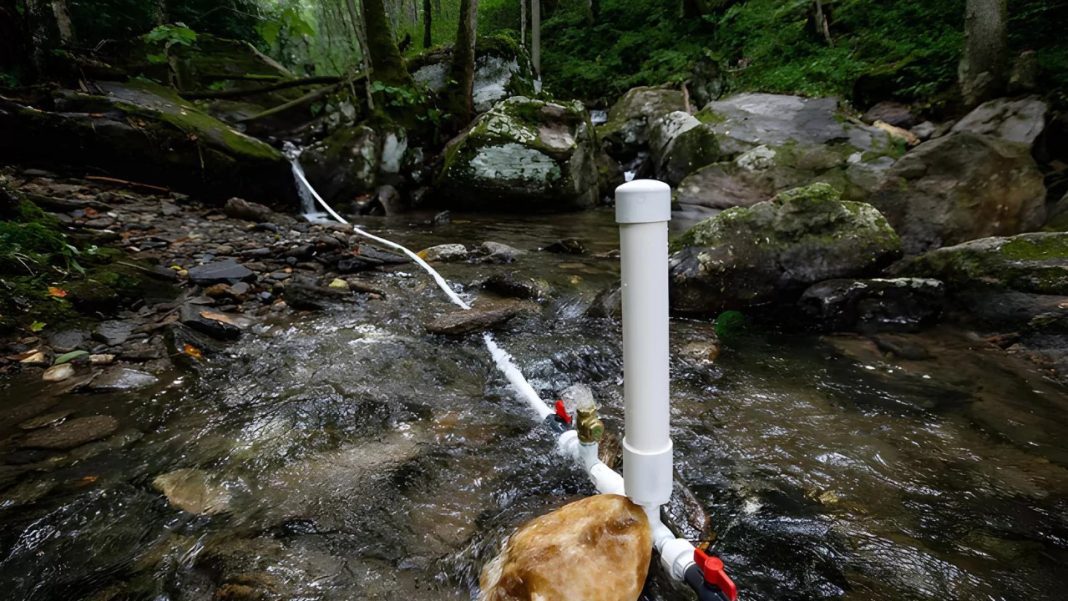Hydraulic ram pumps, commonly known as hydram pumps, are ingenious devices used for lifting water using the force of flowing water.
These pumps are unique in that they require no external power source, such as electricity or fuel, to operate. Instead, they use the energy from the water’s flow to pump a smaller portion of the water to a higher elevation.
In this article, we will explore how a hydram pump works, its cost, the concept of hydro water pumps, and the disadvantages of using a hydraulic ram pump.
How Does a Hydram Pump Work?
A hydraulic ram pump operates based on a principle known as “water hammer,” which is the sudden increase in pressure when water flow is abruptly stopped. The basic components of a hydram pump include a drive pipe, a waste valve, a delivery valve, and a pressure chamber.
Here’s how the process works:
- Water Inlet: Water from a source, such as a stream or river, flows through the drive pipe into the pump.
- Waste Valve: The water enters the pump at a high velocity, causing the waste valve to initially open. This rapid flow of water is necessary to generate the pressure needed for the pump to work.
- Water Hammer Effect: When the waste valve suddenly closes due to the speed of the water flow, the water’s momentum creates a pressure spike, known as the water hammer. This pressure forces a portion of the water through a one-way delivery valve into an elevated pressure chamber.
- Water Delivery: Once the pressure builds up, water is pushed into a delivery pipe to a storage tank or a higher elevation for irrigation, livestock watering, or other applications.
- Cycle Repeats: The cycle continues as long as water flows into the drive pipe. The hydram pump operates automatically without requiring any external power source.
How Much Does a Hydram Pump Cost?
The cost of a hydraulic ram pump can vary depending on several factors, such as its capacity, materials used, and manufacturer. On average, the price for a basic hydraulic ram pump can range from $200 to $1,500.
Smaller pumps for domestic or agricultural use, with lower water lifting capabilities, tend to cost around $200 to $500. For larger, more robust models capable of pumping significant amounts of water to higher elevations, prices can go upwards of $1,000 to $1,500.
Additional installation costs may include pipes, fittings, and the construction of a suitable water source. While the upfront cost can be relatively high, hydraulic ram pumps have the advantage of low operational costs since they don’t require electricity, fuel, or extensive maintenance.
What Is a Hydro Water Pump?
The term “hydro water pump” typically refers to a pump that is powered by hydraulic energy, such as the energy from flowing water used in a hydraulic ram pump. It may also refer to more advanced pumps used in hydroelectric systems to generate electricity. Essentially, a hydro water pump uses water power to move or lift water.
Hydraulic ram pumps are one example of hydro water pumps, as they use the kinetic energy from flowing water to pump a portion of that water to a higher elevation, as mentioned earlier. These pumps are incredibly efficient in regions with a consistent water flow, and they are widely used in rural and off-grid locations for irrigation and water supply.
What Are the Disadvantages of a Hydraulic Ram Pump?
While hydraulic ram pumps are efficient and eco-friendly, they do come with some limitations:
- Limited Water Flow Requirements: A hydram pump requires a constant flow of water to function effectively. The source of water should have enough flow and a certain amount of head (the height of the water source) to generate sufficient pressure for pumping. In areas with low or inconsistent water flow, a hydram pump may not work effectively.
- Elevation Constraints: While hydraulic ram pumps can lift water to significant heights, there is a limit to the maximum elevation they can handle. Typically, these pumps can lift water up to 50 to 300 feet, depending on the water flow rate and system design. If the required lift exceeds this range, alternative pumping solutions may be necessary.
- High Initial Investment: While hydram pumps don’t require ongoing fuel or electricity costs, their upfront cost can be high, especially for larger systems. The cost of installation, including piping and the construction of a water source, should also be factored into the overall expense.
- Maintenance and Durability: While hydram pumps are relatively low-maintenance, they do require periodic checking to ensure that the valves and components are functioning properly. If the pump is not designed for specific environmental conditions (like extreme temperatures or debris-laden water), it may need more frequent maintenance.
- Limited Water Volume: While hydram pumps are excellent for lifting smaller volumes of water to higher elevations, they are not suitable for handling large quantities of water, especially in large-scale irrigation systems. Their capacity is typically limited to a few gallons per minute.
Conclusion
Hydraulic ram pumps are an efficient and environmentally friendly solution for pumping water using the power of flowing water.
They are especially beneficial in off-grid or rural areas where other forms of power generation might not be feasible.
While the initial cost may be higher, the long-term operational savings make them a valuable tool for irrigation and water supply.
However, understanding their limitations—such as water flow requirements, elevation constraints, and maintenance—will ensure that they are used effectively in the right conditions.
Also Read
The cost to replace a water pump: A comprehensive guide
Everything you need to know about Hot Water Circulation Pumps

